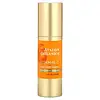What's inside
What's inside
 Key Ingredients
Key Ingredients

 Benefits
Benefits

 Concerns
Concerns

 Ingredients Side-by-side
Ingredients Side-by-side

Aloe Barbadensis Leaf Juice
Skin ConditioningWater
Skin ConditioningGlycerin
HumectantPolyglyceryl-6 Distearate
EmulsifyingHelianthus Annuus Seed Oil
EmollientCetyl Alcohol
EmollientSqualane
EmollientTheobroma Cacao Seed Butter
EmollientAscorbyl Glucoside
AntioxidantGlyceryl Stearate
EmollientTocopheryl Acetate
AntioxidantBorago Officinalis Seed Oil
EmollientCitrus Aurantifolia Oil
CleansingCitrus Aurantium Bergamia Fruit Oil
MaskingCitrus Aurantium Dulcis Peel Oil
MaskingCitrus Nobilis Peel Oil
MaskingCitrus Paradisi Peel Oil
MaskingLinum Usitatissimum Seed Oil
PerfumingRosa Canina Fruit Oil
EmollientArnica Montana Flower Extract
MaskingCamellia Sinensis Leaf Extract
AntimicrobialChamomilla Recutita Flower Extract
MaskingCurcuma Longa Root Extract
MaskingGlycyrrhiza Glabra Root Extract
BleachingLavandula Angustifolia Extract
Skin ConditioningSilybum Marianum Extract
Skin ConditioningTerminalia Ferdinandiana Fruit Extract
AntioxidantAscorbic Acid
AntioxidantTetrahexyldecyl Ascorbate
AntioxidantAlgin
MaskingCalcium Ascorbate
AntioxidantCaprylhydroxamic Acid
Glyceryl Caprylate
EmollientGlyceryl Stearate Citrate
EmollientXanthan Gum
EmulsifyingLimonene
PerfumingLinalool
PerfumingAloe Barbadensis Leaf Juice, Water, Glycerin, Polyglyceryl-6 Distearate, Helianthus Annuus Seed Oil, Cetyl Alcohol, Squalane, Theobroma Cacao Seed Butter, Ascorbyl Glucoside, Glyceryl Stearate, Tocopheryl Acetate, Borago Officinalis Seed Oil, Citrus Aurantifolia Oil, Citrus Aurantium Bergamia Fruit Oil, Citrus Aurantium Dulcis Peel Oil, Citrus Nobilis Peel Oil, Citrus Paradisi Peel Oil, Linum Usitatissimum Seed Oil, Rosa Canina Fruit Oil, Arnica Montana Flower Extract, Camellia Sinensis Leaf Extract, Chamomilla Recutita Flower Extract, Curcuma Longa Root Extract, Glycyrrhiza Glabra Root Extract, Lavandula Angustifolia Extract, Silybum Marianum Extract, Terminalia Ferdinandiana Fruit Extract, Ascorbic Acid, Tetrahexyldecyl Ascorbate, Algin, Calcium Ascorbate, Caprylhydroxamic Acid, Glyceryl Caprylate, Glyceryl Stearate Citrate, Xanthan Gum, Limonene, Linalool
Water
Skin ConditioningCaprylic/Capric Triglyceride
MaskingAlcohol
AntimicrobialSorbitol
HumectantCetyl Alcohol
EmollientGlyceryl Stearate
EmollientGlycerin
HumectantCimicifuga Racemosa Root Extract
AntimicrobialLonicera Caprifolium Extract
AstringentTocopheryl Acetate
AntioxidantUndecylenoyl Glycine
CleansingSodium Stearoyl Glutamate
CleansingLonicera Japonica Flower Extract
Skin ConditioningAloe Barbadensis Leaf Juice Powder
Skin ConditioningSodium Polyacrylate
AbsorbentPhenethyl Alcohol
MaskingParfum
MaskingWater, Caprylic/Capric Triglyceride, Alcohol, Sorbitol, Cetyl Alcohol, Glyceryl Stearate, Glycerin, Cimicifuga Racemosa Root Extract, Lonicera Caprifolium Extract, Tocopheryl Acetate, Undecylenoyl Glycine, Sodium Stearoyl Glutamate, Lonicera Japonica Flower Extract, Aloe Barbadensis Leaf Juice Powder, Sodium Polyacrylate, Phenethyl Alcohol, Parfum
 Reviews
Reviews

Ingredients Explained
These ingredients are found in both products.
Ingredients higher up in an ingredient list are typically present in a larger amount.
Cetyl Alcohol is a fatty alcohol. Fatty Alcohols are most often used as an emollient or to thicken a product.
Its main roles are:
Though it has "alcohol" in the name, it is not related to denatured alcohol or ethyl alcohol.
The FDA allows products labeled "alcohol-free" to have fatty alcohols.
Learn more about Cetyl AlcoholGlycerin is already naturally found in your skin. It helps moisturize and protect your skin.
A study from 2016 found glycerin to be more effective as a humectant than AHAs and hyaluronic acid.
As a humectant, it helps the skin stay hydrated by pulling moisture to your skin. The low molecular weight of glycerin allows it to pull moisture into the deeper layers of your skin.
Hydrated skin improves your skin barrier; Your skin barrier helps protect against irritants and bacteria.
Glycerin has also been found to have antimicrobial and antiviral properties. Due to these properties, glycerin is often used in wound and burn treatments.
In cosmetics, glycerin is usually derived from plants such as soybean or palm. However, it can also be sourced from animals, such as tallow or animal fat.
This ingredient is organic, colorless, odorless, and non-toxic.
Glycerin is the name for this ingredient in American English. British English uses Glycerol/Glycerine.
Learn more about GlycerinGlyceryl Stearate is a mix of glycerin and stearic acid.
It is used to stabilize the mixing of water and oil ingredients. By preventing these ingredients from separating, it can help elongate shelf life. It can also help thicken the product's texture.
As an emollient, it helps soften skin and supports barrier-replenishing ingredients.
In cosmetics, Glyceryl Stearate is often made from vegetable oils or synthetically produced.
This ingredient may not be fungal-acne safe
Fun fact: The human body also creates Glyceryl Stearate naturally.
Learn more about Glyceryl StearateTocopheryl Acetate is AKA Vitamin E. It is an antioxidant and protects your skin from free radicals. Free radicals damage the skin by breaking down collagen.
One study found using Tocopheryl Acetate with Vitamin C decreased the number of sunburned cells.
Tocopheryl Acetate is commonly found in both skincare and dietary supplements.
Learn more about Tocopheryl AcetateWater. It's the most common cosmetic ingredient of all. You'll usually see it at the top of ingredient lists, meaning that it makes up the largest part of the product.
So why is it so popular? Water most often acts as a solvent - this means that it helps dissolve other ingredients into the formulation.
You'll also recognize water as that liquid we all need to stay alive. If you see this, drink a glass of water. Stay hydrated!
Learn more about Water